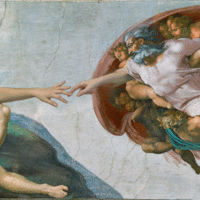More about Madonna
- All
- Info
- Shop

Contributor
While the name may call to mind the ‘80s pop sensation, that’s definitely not who is portrayed in this portrait… but their personalities may not be too different.
After the deaths of Munch’s mother and sister, which he never got over, Munch’s father went bonkers and became heavily invested in religion, at times praying non-stop for days. Munch ended up burnt out on Christianity so he rejected all forms of religion, preferring to follow existentialist philosophies and focus on pondering the human condition. Madonna was Munch’s attempt to make sense of his father’s religion and his own feelings on spirituality through his drunken haze.
The closest to religion that Munch ever got was in his awe of the making, changing, and ultimate end of life. When it came to women, this awe of life lead Munch to conclude that woman’s sole purpose on Earth is childbearing. His ideology mixed with the disturbingly realistic/offensive (depending on your point of view) depiction of the Immaculate Conception (when the Virgin Mary was impregnated by the Holy Spirit with the baby Jesus) drives many viewers to the point of anger. Madonna’s quiet confidence, calm demeanor, and modest expression are definitely all reminiscent of classic depictions of the Holy Mother, not to mention her eyes averted from the mysterious glowing light in the corner, kinda like old depictions of the Annunciation when Mary averts her eyes from the angel Gabriel. But this lady is buck naked and her back is twisted like she’s in the middle of having sex. A far cry from the chaste Christian version.
Despite the obvious sacred imagery, there’s something really hellish about this Holy lady. It’s reminiscent of the movie “Rosemary’s Baby”. Her blood red halo, to Munch, symbolizes the pain, passion, and life that women bring to the lives of men, especially at the moment when Munch captures this honey: while she's getting knocked up. Her sickening aura is indicative of Munch’s fear of being taken over and lost in sexual relationships. She is Munch’s ideal femme fatale. Madonna encompasses all 3 levels of what Munch perceives as female sexuality: woman as a newly awakened sexual being, woman as the seducer and destroyer, and woman as death at the end of her fertility. Munch definitely admires this woman, but he’s also afraid of her and her power over men. In Munch’s mind, love and death walk hand in hand.
In Edvard’s own words, “illness, madness, and death are the black angels that kept watch over my cradle” and a more accurate description of Munch’s upbringing, adult life, and work has never been uttered. His works became a quest to figure out how to exist in a world where illness, madness, and death are the only things he’s ever known and this work is the chapter where he shares his views on women.
Sources
- "Madonna, 1894–95," Norsk, , accessed July 25, 2017, http://nasjonalmuseet.no.
- “Madonna, 1894 by Edvard Munch”, Edvard Munch Paintings, Biography, and Quotes, accessed July 23, 2017, https://www.edvardmunch.org/madonna.jsp
- Documentary (United States of America: Kultur, 2001), February 22, 2013, accessed July 25, 2017, https://www.youtube.com/watch?v=6hobmAPx0so.















